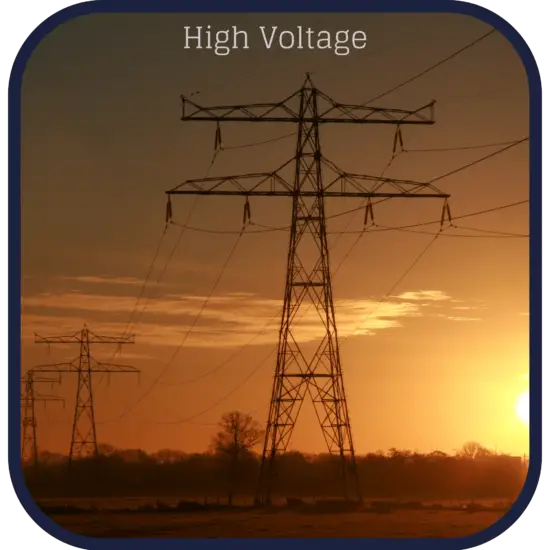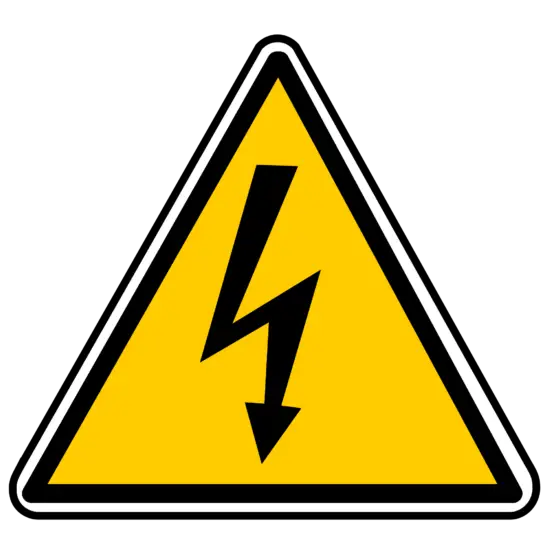30-second summary
High Voltage – HV
High voltage is simply a voltage above a given threshold. In the context of building wiring and the general use of an electrical apparatus, the International Electrotechnical Commission defines:
- high voltage as more than 1,000 volts (V) of alternating current (AC) and above 1,500 V of direct current (DC).
ANSI C84.1-2020 defines:
- high voltage as 115 kV to 230 kV,
High and extra-high voltages are associated with supply transmission from the power plant. The reason for transmitting power at high and extra-high voltage levels is to increase efficiency.

High Voltage – HV
High voltage is simply a voltage above a given threshold. In the context of building wiring and the general use of an electrical apparatus, the International Electrotechnical Commission defines:
- high voltage as more than 1,000 volts (V) of alternating current (AC) and above 1,500 V of direct current (DC).
In the United States, the American National Standards Institute (ANSI) establishes nominal voltage ratings for 60 Hz electric power systems over 100 V. Specifically, ANSI C84.1-2020 defines:
- low voltage as 240 to 600 V
- medium voltage as 2.4 to 69kV
- high voltage as 115 kV to 230 kV,
- extra-high voltage as 345 kV to 765 kV,
- and ultra-high voltage as 1,100 kV.
High and extra-high voltages are associated with supply transmission from the power plant. The reason for transmitting power at high and extra-high voltage levels is to increase efficiency. The lower current accompanying the high voltage transmission allows for the use of thinner lighter-weight cables. This reduces the cost in the tower and electrical line construction. The United States transmits up to 500,000 volts on the high voltage grid.
The most common form of transporting electric power is three-phase systems. Three parallel conductors are cooperating to transfer energy with as small losses as possible. When using DC power for transport is only needed one conductor and losses in that conductor will also be less than for AC. Transmission lines mostly use high-voltage AC (alternating current), but an important class of transmission lines uses high voltage direct current. High-voltage direct current (HVDC) technology offers several advantages compared to alternating current transmission systems. For example, it allows more efficient bulk power transfer over long distances. As the HVDC transmission systems integrate into the electrical power system, it can be noticed improved reliability, stability and, not the least, the transmission capacity of the system. However, the cost is an important variable in the equation. The voltage level is changed with transformers, stepping up the voltage for transmission, then reducing voltage for local distribution and then use by customers.
Electric Power Transmission
Power stations produce usually electricity at high voltage (let’s say 25,000V). Electricity is sent through the national grid at 400,000V, 275,000V, or 132,000V. Step-up transformers at power stations produce the very high voltages needed to transmit electricity through the national grid’s power lines. But because high voltages are too dangerous for use in the home, step-down transformers are then used locally to reduce the voltage to safe levels. The American continent uses a low voltage of 110 to 120 volts (AC), while Europe, Asia, and Africa uses also low voltage but 220 to 240 volts (AC).
We must note that different voltages and different grid frequencies are used in the world.
Classification of Voltage Levels
The electric power can be generated, transmitted and utilized in different voltages. We must note that different definitions are used in electric power transmission and distribution, compared with electronics design. In addition, different voltages and different grid frequencies are used in the world. In the United States, the National Electrical Code (NEC) and the National Electrical Manufacturer’s Association (NEMA) have guidelines and standards that cover all voltage classifications. The American National Standards Institute (ANSI) oversees the creation, promulgation, and use of thousands of guidelines and standards that affect businesses.
NOTE:This page is for informational use only. Always consult with a certified professional when designing and working on electrical equipment. Never work on energized circuits or perform duties that you are not qualified for.
Classification of Voltage Levels- ANSI
In the United States, the American National Standards Institute (ANSI) establishes nominal voltage ratings for 60 Hz electric power systems over 100 V. Specifically, ANSI C84.1-2020 defines:
- low voltage as 240 to 600 V
- medium voltage as 2.4 to 69kV
- high voltage as 115 kV to 230 kV,
- extra-high voltage as 345 kV to 765 kV,
- and ultra-high voltage as 1,100 kV.
Classification of Voltage Levels – BS 7671
British Standard BS 7671:2008 defines high voltage as any voltage difference between conductors that is higher than 1000 VAC or 1500 V ripple-free DC, or any voltage difference between a conductor and Earth that is higher than 600 VAC or 900 V ripple-free DC.
Classification of Voltage Levels- IEC
In the context of building wiring and the general use of an electrical apparatus, the International Electrotechnical Commission defines:
- high voltage as more than 1,000 volts (V) of alternating current (AC) and above 1,500 V of direct current (DC).
- low voltage as voltage between 50 – 1,000 volts of alternating current and between 120 – 1,500 V of direct current.
- extra-low voltage as lower than 50 V of alternating current and 120 V of direct current
Classification by Electricians

“High voltage” in an everyday work setting is geared toward warning unqualified persons that an item poses enough electricity to harm or kill them. For electrical workers, “high voltage” refers to an elevated risk threshold. In this context, the term tells workers valuable information about the nature of the system they are working on to allow them to make informed decisions about working safely. Unprotected high-voltage equipment must also be separated from work spaces in which unqualified persons are present, labeled with warning signs, and protected by a locked barrier or security person. Voltages over approximately 50 volts can usually cause dangerous amounts of current to flow through a human being who touches two points of a circuit, so safety standards are more restrictive around such circuits.
In automotive engineering, high voltage is defined as voltage in range 30 to 1000 VAC or 60 to 1500 VDC.
Typical voltages
To help compare different orders of magnitude, the following list describes typical voltage levels.
- 1.5V (DC) – A common open circuit voltage for non-rechargeable alkaline batteries (e.g. AAA, AA, and C cells).
- 3.8V (DC) – Almost all smartphone batteries work at 3.8 volts. In order to make current flow from the charger to the battery, there must be a potential difference. Therefore battery chargers or USBs for almost all smartphones provide a voltage of 5V.
- 12V (DC) – A common voltage for automobile batteries is 12 volts (DC).
- 110 – 120V (AC) – The most common electrical outlet in any home. The American continent uses a voltage of 110 to 120 volts (AC) while Europe, Asia, and Africa use 220 to 240 volts (AC).
- 3kV – Voltage required to generate every 1mm of an electric arc. Air is a very bad conductor of electricity and has high dielectric strength. The dielectric strength of air is nearly 3000V/mm.
- 110kV – The voltage in electric power transmission lines used to distribute electricity from power stations can be several hundred times greater than consumer voltages, typically 110 to >500 kV (AC).
- 300 MV – A typical lightning flash is about 300 million Volts and about 30,000 Amps.
Frequently asked questions
In the context of building wiring and the general use of an electrical apparatus, the International Electrotechnical Commission defines high voltage as more than 1,000 volts (V) of alternating current (AC) and above 1,500 V of direct current (DC).
Low voltage is an electrical voltage that is referred to in the consumer segment as the main voltage used for commercial electrical appliances and lighting in homes and industry. Electrical voltages that do not exceed the specified limit values are referred to as low voltage. According to the ANSI C84.1-2020: low voltage is between 240 to 600 V. According to the IEC: low voltage is the voltage between 50 – 1,000 volts of alternating current and between 120 – 1,500 V of direct current.
1.5V (DC) – A common open circuit voltage for non-rechargeable alkaline batteries (e.g. AAA, AA and C cells).
3.8V (DC) – Almost all smartphone batteries work at 3.8 volts. In order to make current flow from the charger to the battery, there must be a potential difference. Therefore battery chargers or USBs for almost all smartphones provide a voltage of 5V.
12V (DC) – A common voltage for automobile batteries is 12 volts (DC).
110 – 120V (AC) – The most common electrical outlet in any home. The American continent uses a voltage of 110 to 120 volts (AC) while Europe, Asia and Africa use 220 to 240 volts (AC).

